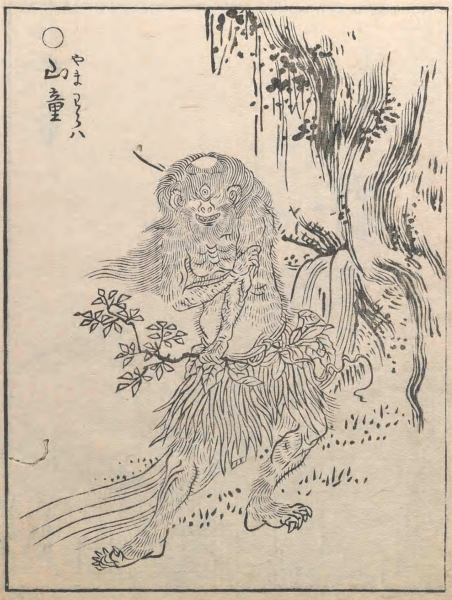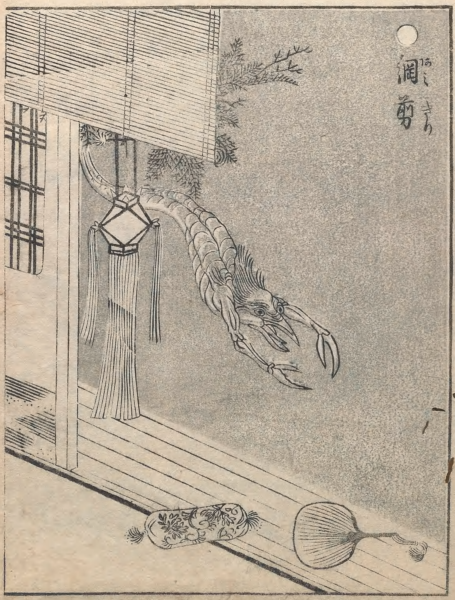Quite surprisingly, Joly & Inada in their translation of Sekien’s Gazu hyakki yagyō 畫圖百鬼夜行 start by quoting sort of a mystery preface. It is signed by some Setchuan Riota and dated Anyei 6, that is 1777—a little unlikely for a book that was published the year before, in 1776. Consequently, this preface couldn’t have been part of the original 1776 publication, and first I guessed that it might possibly come from the Konjaku zoku hyakki 今昔続百鬼 of 1779, but that would still be an extremely early, but not impossible date for a preface.
Yet, so far, I cannot identify any copy of that book with a Setchuan Riota preface. It is anyway quite difficult to locate copies of these Sekien books on the internet. Although ghosts and yokai and yurei seem to be extremely popular these days, Sekien’s books at least failed to attract the early French collectors which might likely help me finding one of these fantastic entries by Charles Vignier in some auction catalogue: Hayashi had a copy of the original 1779 edition (cat 1588); and for the Gazu Hyakki yagyō, Henri Vever had a copy of the 1776 edition (1948: 284, now Freer Gallery of Art, Washington, ex Gerhard Pulverer); and Haviland had a copy of the 1805 edition published by Maekawa Rokuemon and Maekawa Yahei (X: 513), and that’s it. And whereas Jack Hillier took this as an indication of their rarity, I would rather suggest that this kind of pictures did not suit the French taste.

As for the Konjaku zoku hyakki, the Smithsonian Library in Washington has a copy of the 1805 reprint with two prefaces by Nibushian Dōjin and Sekien himself, Leiden has a copy of the 1805 edition with only the Sekien preface (RV-1-4459), and UCLA has just the vols 2 and 3, so no preface there.
As for the Gazu Hyakki yagyō, I then finally also found a copy in the National Diet Library, Tokyo (辰 6-23) with, yes, the Setchuan Riota preface. And that is apparently of a much later ’1805’ edition, issued by Naganoya Kankichi 長野屋勘吉 of Tsu in Ise Province—which must be similar to the copy owned by Regamey. And so I could identify him as Setchūan Ryōta 雪中菴蓼太, seals Tōei and Yōkyō 印: 冬英, 揚喬, actually Setchūan III, a pen-name of Ōshima Ryōta 大島蓼太 1718-1787, and his preface is, indeed, dated Anei rokunen tori shōgatsu 安永六年酉正月 (Anei 6 year of the Cock, I/1777). And though this still doesn’t solve the mystery where it comes from, let’s cite it anyway for the moment, as it is such a nice piece of writing, hoping I will some day find where it really fits or belongs:
One day I went out for a walk passing Toyeizan (Temple Uyeno [Ueno Tōeizan 上野東叡山]) looking at the fallen flowers as I strolled through Negishi [根岸, a location favoured by writers and artists, such as Sakai Hōitsu, Kitao Shigemasa, and Kameda Bōsai, who all lived there] where the wisteria was just in bloom, passing through Higurashi [a village in the Nippori District] where the yamabuki [山吹 Japanese rose] was full open, and I paid a visit to the studio of Sekiyen. A boy told me that the artist was not in but would soon return, he offered me some tea and soon after I felt very sleepy, a few bees came out of their hives and made a great noise, and I thought of the old story in which someone used his sword to drive flies away. A man who drove flies away with his sword must have been in such circumstances, and I attacked the hives with my stick, with the help of the boy, and then the bees flew about the hives and suddenly changed into many small men, and amongst them there were Soshi (strong men [壮士 henchmen]) a fine woman, wise men and fools, a priest, etc, and they spoke human words; understood and acted as if they were large men, and I was looking at them, leaning forward to the writing desk, I was then awakened by my friend who had just returned. I was startled (bonyari [ぼんやり]) & I realized that there were a few bees flying about the house. I still had a feeling as if I had just returned from a far country (kwaikankoku [怪漢国 the Land of Suspicious-looking People]). My friend said: I have just illustrated Suikoden [Suiko gasenran 水滸画潜覧 published in 1777], and then when he showed me his drawings I realized that all the different illustrations were just the little personages of whom I had just dreamt.
I wonder whether I have also dreamt about all the illustrations in this book. Recently a publisher asked him for these and Sekiyen accepting the offer asked me to write the preface, having no reason to decline his request I take my pen.
Setchuan Riota, Anyei 6 [1777]

Reading the text a few times, it then suddenly occurred to me that the original source might well have been the Suiko gasenran, which was published in 1777, altogether fine with the dating of the preface. It is a 3-volume publication of Izumoji Izuminojō 出雲寺和泉掾 and Enshūya Yashichi 遠州屋弥七, also the original publishers of Sekien’s ghost books, that might well have ended up likewise with Naganoya Kankichi in Setsu, who then mixed up the various components of Sekien’s books.
Again, it was not easy to locate a copy of this book, but the Museum of Fine Arts in Boston has two copies, both not yet photographed, so I asked Sarah Thompson for help. She kindly promised to check the books next time she would have an opportunity to get to the collection. And something like a week later, there already was her reply: Hit, the preface is the one belonging to the Suiko gasenran, only found in the complete 3-volume copy (MFA 2009.3761 – the other copy, in MFA 2011.1444 is incomplete). Great, Sarah, thank you so much, now we know where the preface comes from. But when did Naganoya Kankichi make this mix-up? As Siebold was in the 1820s still able to get copies of the 1805 edition of both Zoku hyakki yagyō and Hyakki Tsurezurebukuro, it would seem that Naganoya was active even later than the 1820s—unless, of course, the Siebold copies were bought from some antiquarian bookshop, which he seems to have hardly done.